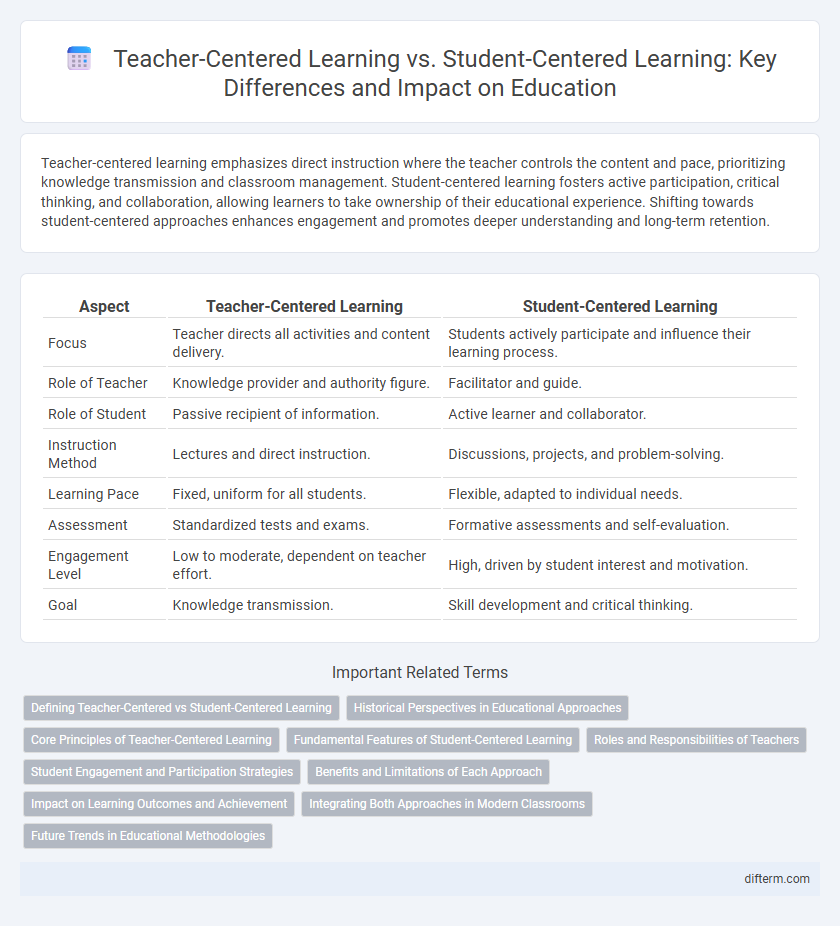Teacher-centered learning emphasizes direct instruction where the teacher controls the content and pace, prioritizing knowledge transmission and classroom management. Student-centered learning fosters active participation, critical thinking, and collaboration, allowing learners to take ownership of their educational experience. Shifting towards student-centered approaches enhances engagement and promotes deeper understanding and long-term retention.
Table of Comparison
| Aspect | Teacher-Centered Learning | Student-Centered Learning |
|---|---|---|
| Focus | Teacher directs all activities and content delivery. | Students actively participate and influence their learning process. |
| Role of Teacher | Knowledge provider and authority figure. | Facilitator and guide. |
| Role of Student | Passive recipient of information. | Active learner and collaborator. |
| Instruction Method | Lectures and direct instruction. | Discussions, projects, and problem-solving. |
| Learning Pace | Fixed, uniform for all students. | Flexible, adapted to individual needs. |
| Assessment | Standardized tests and exams. | Formative assessments and self-evaluation. |
| Engagement Level | Low to moderate, dependent on teacher effort. | High, driven by student interest and motivation. |
| Goal | Knowledge transmission. | Skill development and critical thinking. |
Defining Teacher-Centered vs Student-Centered Learning
Teacher-centered learning emphasizes direct instruction where the teacher is the primary authority delivering content, guiding the classroom, and assessing student performance. In contrast, student-centered learning prioritizes active student engagement, encouraging collaboration, critical thinking, and personalized learning experiences tailored to individual needs. This pedagogical shift influences curriculum design, classroom management, and the role of assessment in measuring understanding and skills development.
Historical Perspectives in Educational Approaches
Teacher-centered learning, dominant in traditional classrooms, emphasizes a structured curriculum with the teacher as the primary knowledge authority, reflecting educational practices from the early 20th century. Student-centered learning emerged mid-20th century, influenced by constructivist theories from educational theorists like John Dewey and Jean Piaget, prioritizing active student engagement and personalized learning experiences. This historical shift highlights a move from passive reception of knowledge to fostering critical thinking and collaboration in educational settings.
Core Principles of Teacher-Centered Learning
Teacher-centered learning emphasizes structured instruction where the educator directs the educational process, controlling content delivery and pacing to ensure foundational knowledge acquisition. Core principles include a focus on teacher authority, standardized curriculum, and assessment methods designed to evaluate student comprehension efficiently. This approach prioritizes mastery of specific skills and factual information before encouraging independent critical thinking.
Fundamental Features of Student-Centered Learning
Student-centered learning prioritizes active student engagement, personalized instruction, and collaborative activities that foster critical thinking and problem-solving skills. It emphasizes learners' autonomy, encouraging inquiry-based exploration and self-paced progression through the curriculum. Assessment strategies in this approach focus on formative feedback and real-world application, promoting deeper understanding and long-term knowledge retention.
Roles and Responsibilities of Teachers
In teacher-centered learning, teachers primarily act as knowledge transmitters, controlling the curriculum, pacing, and classroom management to ensure content mastery. In student-centered learning, teachers shift to facilitators and guides, fostering critical thinking and collaboration by encouraging student autonomy and active participation. Effective educators adapt their roles to balance direct instruction with supportive mentorship, aligning teaching strategies with students' diverse needs and learning styles.
Student Engagement and Participation Strategies
Teacher-centered learning relies on direct instruction and lecture-based methods, often limiting student engagement and passive participation. Student-centered learning emphasizes active learning strategies such as collaborative projects, discussion-based activities, and hands-on experiences that increase motivation and foster deeper understanding. Techniques like peer teaching, problem-solving tasks, and interactive technology tools enhance participation and promote critical thinking skills.
Benefits and Limitations of Each Approach
Teacher-centered learning provides structured content delivery, ensuring curriculum coverage and clear assessment criteria, but may limit student engagement and critical thinking development. Student-centered learning fosters active participation and critical problem-solving skills, promoting deeper understanding, though it can challenge classroom management and curriculum pacing. Balancing both approaches maximizes educational outcomes by integrating direct instruction with collaborative, inquiry-based learning methods.
Impact on Learning Outcomes and Achievement
Teacher-centered learning often leads to standardized achievement but may limit critical thinking and creativity due to passive knowledge absorption. Student-centered learning enhances engagement, promotes deeper understanding, and improves critical thinking skills, resulting in higher retention and overall academic performance. Studies indicate that incorporating active learning strategies significantly boosts student achievement and long-term knowledge application.
Integrating Both Approaches in Modern Classrooms
Integrating teacher-centered and student-centered learning approaches in modern classrooms enhances educational effectiveness by balancing structured instruction with active student engagement. Combining direct teaching methods with collaborative projects and inquiry-based activities fosters critical thinking, personalized learning, and improved academic outcomes. This blended strategy supports diverse learning styles and promotes a more inclusive and dynamic educational environment.
Future Trends in Educational Methodologies
Future trends in educational methodologies emphasize a shift from teacher-centered learning, characterized by passive knowledge transmission, to student-centered learning that fosters critical thinking, collaboration, and personalized learning experiences. Technologies such as AI-driven adaptive learning platforms and immersive virtual reality environments empower students to take active roles in their education, enhancing engagement and deeper understanding. The increasing integration of data analytics in classrooms supports tailored instructional strategies, promoting competency-based education and lifelong learning skills essential for the evolving job market.
teacher-centered learning vs student-centered learning Infographic

 difterm.com
difterm.com